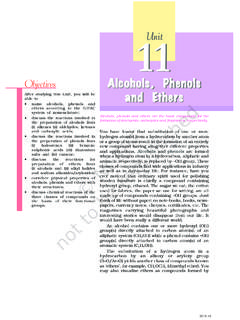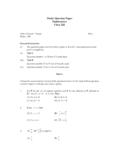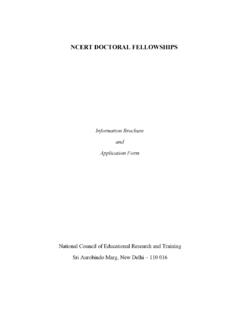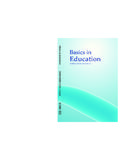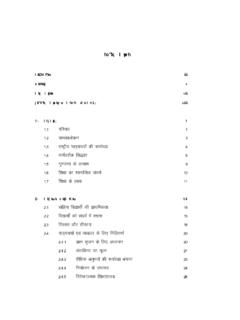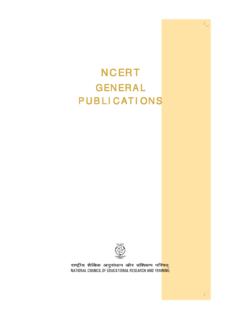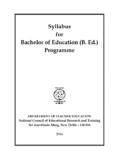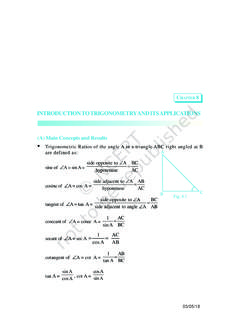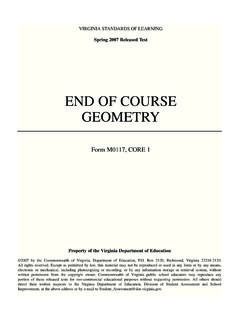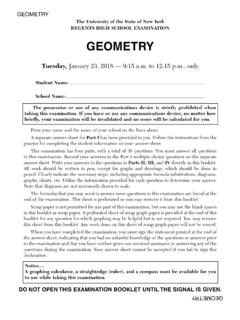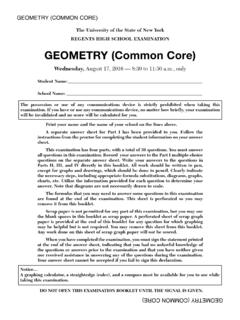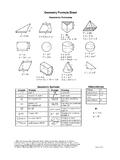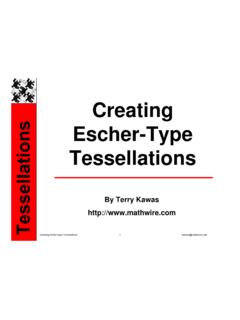Transcription of www.ncert.nic.in
1 A line segment corresponds to the shortest distance between twopoints. The line segment joining points A and B is denoted as AB oras BA. A ray with initial point A and a point B on it is denoted asAB . Line AB is denoted as AB . Two distinct lines in a plane that cross at a point are calledintersecting lines, otherwise they are called parallel lines. Two rays with a common initial point form an angle. A simple closed curve made of line segments only is called a polygon. A polygon of three sides is called a triangle and that of four sides iscalled a quadrilateral. A polygon with all its sides equal and all its angles equal is called aregular polygon.
2 A figure, every point of which is equidistant from a fixed point iscalled a circle. The fixed point is called its centre and the equaldistance is called its radius. In examples 1 and 2, write the correct answer from the given 1:The number of diagonals of a pentagon is(A)3(B)4(C)5(D)10 Solution:Correct answer is (C). Example 2:The number of diagonals of a triangle is(A)0(B)1(C)2(D)3 Solution:Correct answer is (A).In examples 3 and 4, fill in the blanks to make the statements true:Example 3:A polygon of six sides is called a :HexagonExample 4:A triangle with all its sides of unequal lengths is called a_____ :ScaleneIn examples 5 to 7, state whether the statements are true or 5:Two non-parallel line segments will always :False (Hint: They will intersect, when they are produced)Example 6:All equilateral triangles are isosceles :TrueExample 7:Angle of 0 is an acute :False [Hint: Measure of acute angle is between0 and 90 ]Example 8:In Fig.
3 , PQAB and PO = PQ the perpendicular bisector ofline segment AB? Why or why not?Solution:PQ is not the perpendicularbisector of line segment AB,because AO BO. [Note: AB is theperpendicular bisector of linesegment PQ].Example 9:In Fig. , if ACBD , then nameall the right :There are four right angles. Theyare: APD , APB , BPC andCPD .ABPQOFig. Example 10:Is ABCD of Fig. a polygon? If yes,what is the special name for it?Solution:Yes, it is a polygon, because it is asimple closed figure made of linesegments only. It is a 11:In Fig. , BCDE is a square and a 3D shape has beenformed by joining the point A in space with the verticesB, C, D and E.
4 Name the 3D shape and also its (i) vertices,(ii) edges and (iii) :The 3D shape formed is a squarepyramid.(i)Vertices are A, B, C, D and E.(ii)Edges are AB, AC, AD, AE, BC,CD, DE and EB.(iii)Faces are: square BCDE andtriangles ABC, ACD, ADE 12 :Write the measure of smaller angle formed by the hourand the minute hands of a clock at 7 O clock. Also,write the measure of the other angle and also state whattypes of angles these :Measure of the required angle = 30 + 30 + 30 + 30 +30 = 150 Measure of the other angle = 360 150 = 210 Angle of measure 150 is an obtuse angle and that of210 is a reflex angle.
5 In each of the questions 1 to 16, out of four options only one is the correct of lines passing through five points such that no three ofthem are collinear is(A)10(B)5(C)20(D)8 Fig. number of diagonals in a septagon is(A)21(B)42(C)7(D) of line segments in Fig. is(A) 5(B)10(C)15(D)20 Fig. of the two angles between hour and minute hands of aclock at 9 O clock are(A)60 , 300 (B)270 , 90 (C)75 , 285 (D)30 , 330 a bicycle wheel has 48 spokes, then the angle between a pair oftwo consecutive spokes is (A)152 (B)172 (C)211 (D)215 Fig. , XYZ cannot be written as(A) Y(B) ZXY(C) ZYX(D) Fig , if point A is shifted topoint B along the ray PX such thatPB = 2PA, then the measure of BPY is(A)greater than 45 (B) 45 (C) less than 45 (D) 90 number of angles in Fig.
6 Is(A)3(B)4(C)5(D)6 Fig. YXBA40 20 30 number of obtuse angles in Fig. is(A)2(B)3(C)4(D) number of triangles in Fig. is(A)10(B)12(C)13(D) the sum of two angles is greater than 180 , then which of thefollowing is not possible for the two angles?(A)One obtuse angle and one acute angle(B)One reflex angle and one acute angle(C)Two obtuse angles(D)Two right the sum of two angles is equal to an obtuse angle, then which ofthe following is not possible?(A)One obtuse angle and one acute angle.(B)One right angle and one acute angle.(C)Two acute angles.(D)Two right polygon has prime number of sides.
7 Its number of sides is equal tothe sum of the two least consecutive primes. The number of diagonalsof the polygon is(A)4(B)5(C)7(D)10 Fig. 45 65 30 Fig. , AB = BC and AD = BD = number of isoscles triangles in the figure is(A)1(B)2(C)3(D) Fig. , BAC = 90 and AD number of right triangles in the figure is(A)1(B)2(C)3(D) Fig. , PQ RQ, PQ = 5 cm and QR = 5 cm. Then PQR is(A)a right triangle but not isosceles(B)an isosceles right triangle(C)isosceles but not a right triangle(D)neither isosceles nor right triangleIn questions 17 to 31, fill in the blanks to make the statements angle greater than 180 and less than a complete angle is number of diagonals in a hexagon is pair of opposite sides of a trapezium are Fig.
8 , points lying in the interior ofthe triangle PQR are _____, that in theexterior are _____ and that on the triangleitself are Fig. , points A, B, C, D and E are collinear such thatAB = BC = CD = DE. Then(a)AD = AB + _____(b)AD = AC + _____(c)mid point of AE is _____(d)mid point of CE is _____(e)AE = _____ Fig. ,(a)AOD is a/an _____ angle(b)COA is a/an _____ angle(c)AOE is a/an _____ number of triangles in Fig. is names are of angles less than 180 inFig. is _____and their names number of straight angles in Fig. number of right angles in a straightangle is _____ and that in a complete angleis number of common points in the two angles marked inFig.
9 Is number of common points in the two angles marked inFig. is number of common points in the two angles marked inFig. _____ .ABRPEQDCFFig. number of common points in the two angles marked inFig. is common part between the two angles BAC and DAB in Fig. whether the statements given in questions 32 to 41 are true (T)or false (F) horizontal line and a vertical line always intersect at right the arms of an angle on the paper are increased, the angle the arms of an angle on the paper are decreased, the angle line PQ || line m, then line segment PQ || parallel lines meet each other at some of ABC and CBA in Fig.
10 Are the line segments may intersect at two lines can pass through two given one line can pass through a given angles can have exactly five points in all the line segments in Fig. Fig. the line segments shown in Fig. the mid points of all the sides of Fig. the vertices and the line segments in Fig. down fifteen angles (less than 180 ) involved in Fig. the following angles of Fig. , using three letters:(a) 1(b) 2(c) 3(d) 1 + 2(e) 2 + 3(f) 1 + 2 + 3(g) CBA the points and then the line segments in each of the followingfigures (Fig. ):(i)(ii) (iii) (iv)Fig.
